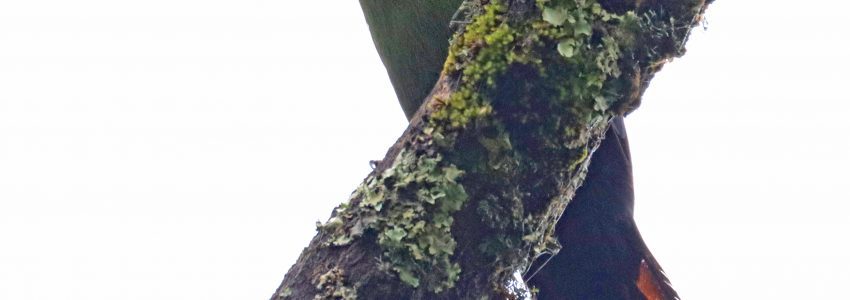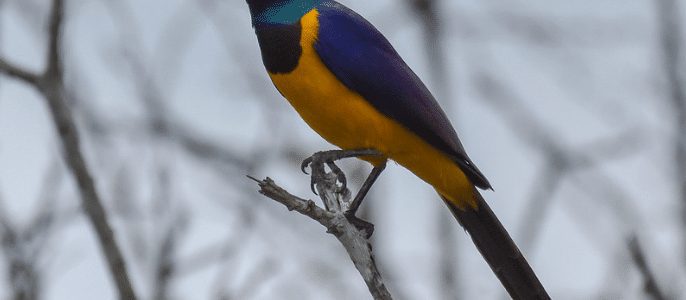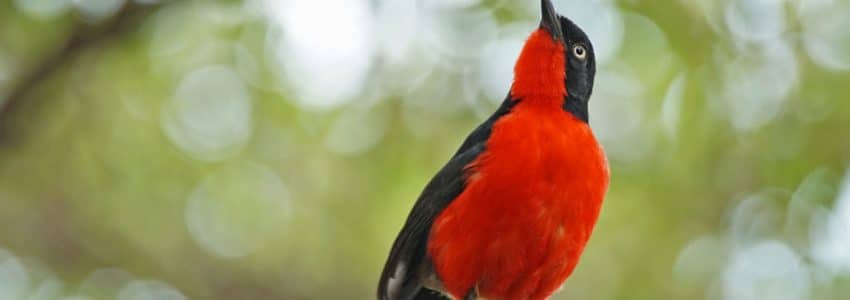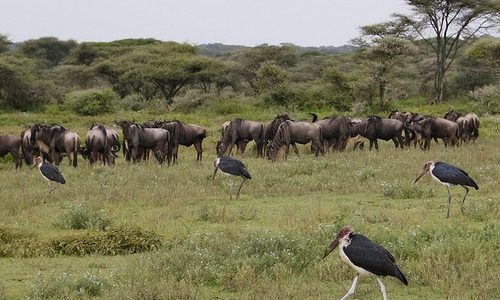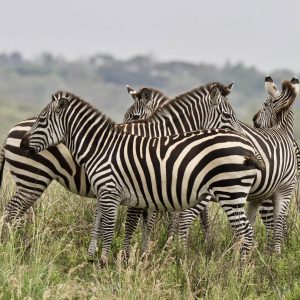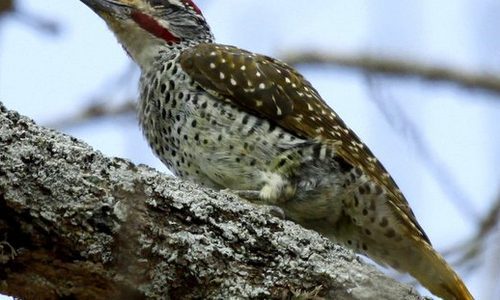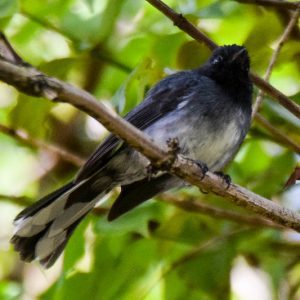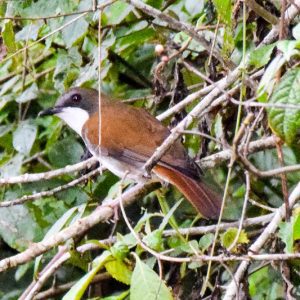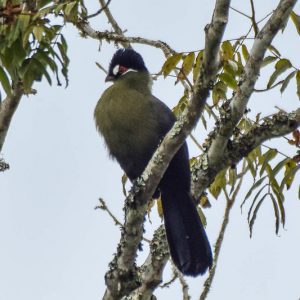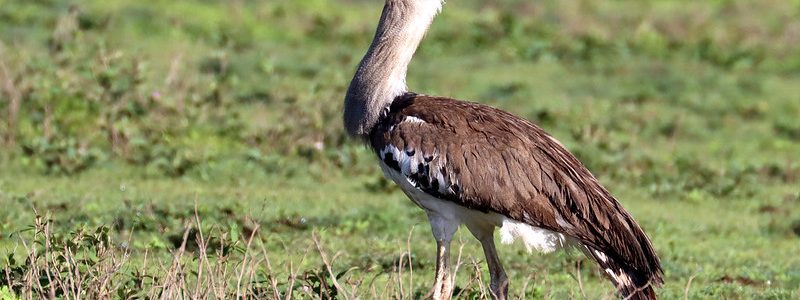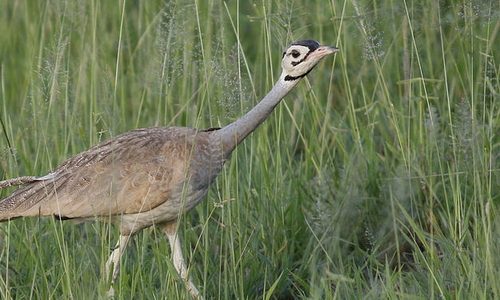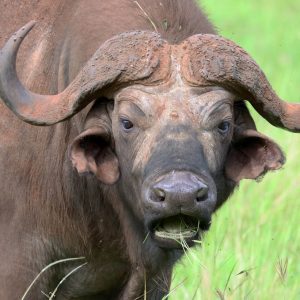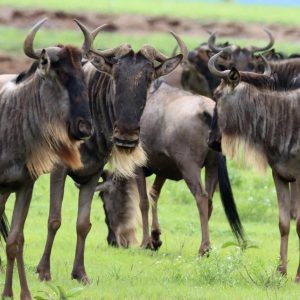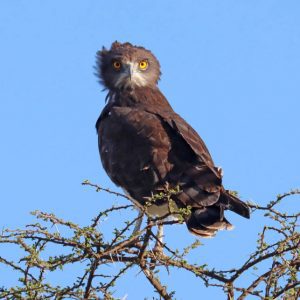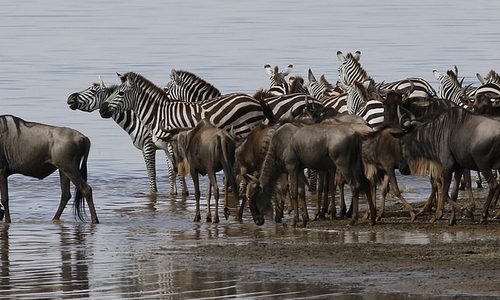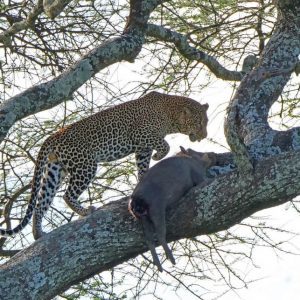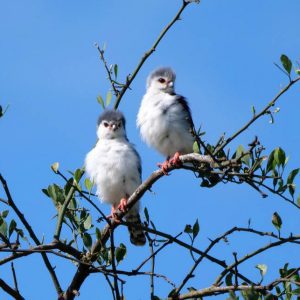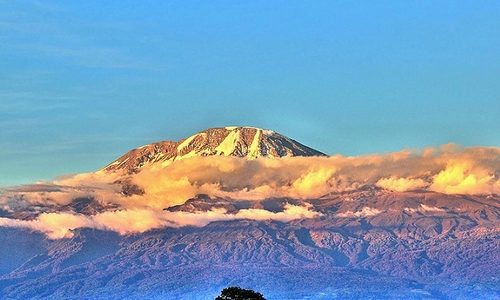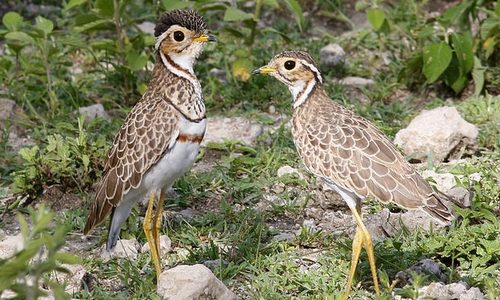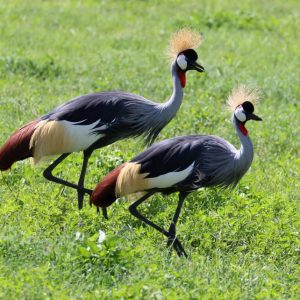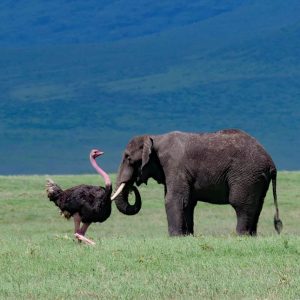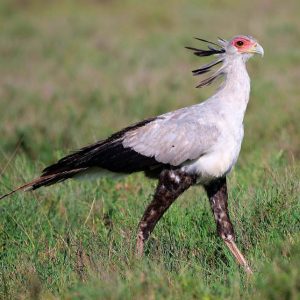Targets the Beesley`s Lark and the Spot Throat! Read more
tanzania
For the Near Endemics and Specialties! Read more
Birding and Wildlife Extravaganza! Read more
9 Days Tanzania Wildlife & Nature Tour
Day 1: On arrival into Tanzania, you are met by our Tanzania birding driver guide at the airport in Kilimanjaro. You then begin the transfer in a custom built safari vehicle through verdant landscape to the Arusha. Depending on time of arrival, you will have couple of stops along the way to spot some bird species before heading to the overnight Hotel in Arusha. Following a short birding trip around the property, the birdguide will go through the itinerary one more time on the final briefing prior to the next day’s program. Birding in the Arusha environs of the hotel introduces: Variable and Scarlet-chested Sunbird, Common Bulbul, Brown-crowned Tchagra, Mourning ,Namaqua Dove, Spotted Eagle-owl, African Black-headed Oriole, Red-headed Weaver, Baglafecht Weaver, White-eared Barbet, Blackcap, Waller’s Starling, African Green Pigeon, Crowned Hornbill.
Overnight at Korona Villa
Day 2: Breakfast at about 8:00am,walk around the Lodge gardens and depart for Arusha National Park with your Picnic boxes for Lunch. You have a full day exploring the Ngurodoto Crater, the famous Momella Crater Lakes as well as clear views of Mount Meru (4500m above sea level), all Big Game including Herds of Buffaloes, Masai Giraffes, Black and white colobus monkeys… will be viewed in their natural habitat with the exception of Rhinos and Lions. Bird checklist of Arusha National park features; Trilling Cisticola, Moustached Grass-Warbler, Mosque Swallow, Red-rumped swallow, Lesser Striped swallow, African Harrier-hawk, Cabanis’s Greenbul, Short-tailed Batis, Horus Swift, Silvery-cheeked Hornbill, Hartlaub’s Turaco, Bar-tailed Trogon, Brown Woodland Warbler, Eastern Mountain Greenbul, White-starred robin and many more. Return to Korona Villa for Dinner and Overnight.
Day 3: An early Breakfast will be taken, and a picnic Lunch will be carried, getting ready for a long drive to the Serengeti plains. En route you will drive through the Masai country side passed the Rift valley escarpment where you will stop for panoramic views of the spectacular Lake Manyara escarpment, continue through the Agricultural township of Karatu into the Ngorongoro Highlands then to Olduvai gorge where you will un-pack your Lunches while listening to Lectures from a resident Archaeologist at the Olduvai gorge – re discovering the fossils of the early man, you will also have chance to visit the Paleontology Museum where the Australopithecus Bosei skeleton was discovered dating million years ago
Continue into the Serengeti Plains with very brief game viewing as it will be approaching sun set. Birds to look out for this day include: Buff-bellied Warbler, Red-faced Crombecs, Winding Cisticolas, Tawny-flanked Prinias, Dideric Cuckoos, White-browed Coucals, Grey-headed Kingfishers, Blue-cheeked Bee-eaters, Cardinal Woodpecker, Black-headed Gonolek, Rufous Chatterers chested Sunbirds, Isabelline Shrike,Angola Swallow, Black-billed Barbet, Pearl-spotted Owlet, Brubru, Black-backecd Puffback, Mariqua Sunbird, Karamoja Apalis, Plantain-eater, Southern Ground Hornbill, Bateleur, Harrier-hawk and Little Sparrow hawk.
Check in at Katikati Tented Camp for Dinner and Overnight.
Day 4: Early rise to catch up with the game as hundreds of Mammals rise out of their dens to begin a typical jungle day,-the Serengeti is famous for her annual Million herds of Wildebeests migrating within the Serengeti –Masai Mara eco –system; Grazers ,Browsers and Carnivores will be seen sharing this great plains in harmony, game viewing and return to the Lodge for your breakfast.
After Breakfast, you will join in for the official Full day game viewing, returning to the Lodge for a hot Lunch. After Lunch you may have the option of either staying in for a nap and go for a late afternoon game viewing once again or relax till next day. Count down your day’s spot list, which may include a handful of Lion Prides, Thomson and Grant Gazelles, Dikdik and other Cats such as the Caracal, Cheetah and Leopard.
Birding in the Serengeti introduces: Common Sandpiper, Black Crakes, Montagu’s Harrier, Black-shouldered Kite, Black-chested Snake-Eagle, White-bellied Bustard, dainty Temminck’s Courser, Rueppel’s Long-tailed Starling, White-headed Buffalo-Weavers, Rufous-tailed Weaver, Lesser Spotted Eagle, Pallid Harrier, Dark Chanting Goshawk, Coqui Francolin, Isabelline Wheatear, Yellow-billed Stork, Klaas’s Cuckoo, Usambiro Barbet, Scarlet-chested Sunbird.
Enjoy your Dinner and overnight at Katikati Camp.
Day 5: Morning at Leisure, Breakfast at own pace, depart with picnic Lunches, to have the last of the Serengeti Plains- taking the last pictures of the Serengeti with chances of catching up with the Kilpspringers and other Antelope species such as Topi, Eland, Water bucks. Enroute to Ngorongoro are Maasai local home stead (locally known as the Maasai Boma, the Maasai will welcome you to visit their home for a “fee”) Rest of the evening relaxing at the Ngorongoro Sopa Lodge balcony with taking views of the crater floor.
Look out for African HillBabbler, Thick-billed Seedeater, Brown Woodland Warbler and Montane White-eyes, Cinnamon Bracken Warbler, Bronze and Green-headed sunbirds, Black-winged Bishop, Holub’s Golden Weaver, Emerald-spotted Wood Dove, White-necked Raven, White-tailed Blue Flycatcher, Black-throated Wattle-eye, Chinspot Batis, Gray-capped and Brown Woodland Warblers, Abyssinian (Olive) Thrush, Brown-headed Apalis, Tambourine Dove, Mountain Wagtail, African Paradise-Flycatcher, Cinnamon-chested Bee-eater and Collared Sunbird, Sharpe’s Starling, Purple-throated and Grey Cuckoo-shrikes, Black-fronted Bushshrike, Narina Trogon, Red-capped Robin-chat, Grey-headed Nigrita, Spectacled Weaver, Moustached Tinkerbird, White-tailed Blue Flycatcher, African Hill Babblers and Montane Nightjar. Dinner and Overnight at Rhino Lodge
Day 6: After the 7:30Am Breakfast, you will descend the crater walls onto the crater floor which has a radius of about 265sqKm. The Crater is uniquely dotted with watering holes and shelters about 30,000 Mammals including the White bearded Gnus, Cheetah and Tanzania’s only Black Rhinos.” This is the eighth wonder of the world and the world’s only remaining memories of the “garden of Eden” better described as Noah’s Ark.. After the excitement at the Crater floor, you will ascend the Crater walls to your Lodge. Birds to look out for this day include; Cape Rook, Kestrel, Chestnut-bellied Sandgrouse, Yellow-throated Sandgrouse, Rufous-crowned Roller, White-throated Bee-eater, Singing Cisticola, Wailing Cisticola, Yellow Bishop, Schalow’s Wheatear, Northern Anteater-Chat, Yellow-fronted canary, Steppe Buzzard, Abdim’s Stork, Rueppell’s Robin-chat, Spur-winged Goose, Saddle-billed Stork, Mountain Yellow Warbler, Hunter’s Cisticola, Eastern Mountain Greenbul, Streaky Seedeater, Cape Robin-chat, Kenrick’s Starling,OlivePigeon, Schalow’s Turaco, Tropical Boubou, Dusky flycatcher, White-eyed Slaty-Flycatcher, Cinnamon-chested Bee-eater. Night at Country Lodge.
Day 7: Depart the Karatu area after breakfast, drive into the jungles of Lake Manyara, Lake Manyara is famous for her tree climbing Lions, large schools of Hippos at the Hippo pool and the Maji moto hot springs. Birding in the Manyara features; Black-crowned Tchagra, Silvery-cheeked Hornbill, Collared Palm-Thrush, Purple-crested Turaco, Yellow-bellied Greenbul, White-backed and Rueppell’s vultures, African Crowned Eagle, African Hawk-eagle, Black Goshawk, African Marsh Harrier, African Fish-Eagle, Bateleur, Common Buzzard, Verreaux’s Eagle-owl,Sulphur-breasted Bush-shrike, Yellow-billed Storks, Great White Pelican, Pink-backed Pelicans, Sacred Ibis, African Spoonbill, Squacco Heron, Purple Heron, Black Heron, White-faced Whistling Duck, Black-winged Stilt, Marsh Sandpiper, Little Stint and Collared Pratincole.
You will then take your picnic Lunch at one of the many Picnic sites set aside by the park Authorities and then continue exploring the Lake Manyara jungles, where a good list of wildlife will be added to your previous record. Drive out of the park boundaries in the evening into E Unoto Retreat Tanzania’s only true 5 Star Luxury Lodge set in a remote Maasai Country where bird walks can be arranged.
Day 8: We will have an optional Pre breakfast bird walk around the Gibba Farm, after breakfast you will have the option to go out game viewing full day back in the Manyara Jungles or just relax at your Balcony where birding opportunities are superb. Look out for Water Thick-knee,Long-toed plover, Blacksmith plover ,Spur-winged Plovers, African Jacana, European Bee-eaters, African Swamp hen, Red-and-Yellow Barbet, Mocking Cliff Chat, Bearded Woodpecker, Scimitarbill, Crowned Hornbill, African Black-headed Oriole, Collared Palm Thrush White-headed Barbet, Southern Citril, Spot-flanked Barbet, African Green Pigeon, Red-headed Weaver, Eastern Nicator
You can then later join in a walk exploring the local surroundings where again you will have further chances of birding for waders and a mix of dry country species as well as meeting up with the local people. Later, dinner and overnight at your Lodge.
Day 9: Leisurely Breakfast, Lunch at the Lodge and drive to Arusha to catch a PM flight home or transfer to Nairobi.
END OF SERVICES
10 DAYS: TANZANIA BIRDING EXPRESS
USAMBARAS – TANZANIA EXPRESS
Our new Tanzania Birding Express are meant to offer an un-beatable birding experience to visitors in the country with very limited time available, actually those who would wish to “bird on borrowed time” off business or conference in Dar es salaam or Arusha.
Note: Tour can be booked on last minute – subject to availability of bird guide and accommodations depending on time of year.
NORTH EASTERN TANZANIA BIRDING EXPRESS (Option 2)
Specialty Birding and endemics Tour to the East Usambara Mountains and Amani Nature Reserve North Pare Mountains, West Usambara Mountains,Mkomazi NP and Nyumba Ya Mungu water Reservoir )
Day 1: Pick from your Hotel in Arusha,drive to the Lark Plains North of Arusha,rest of the day birding. Night in Arusha booked by Tanzania Birding & Beyond Safaris.
Day 2:Drive to the North Pare Mountains, Birding for dry country specialties and on to Lushoto in the West Usambara Mountians.
Day 3: Birding West Usambara Mountains Endemics and Specialties.
Day 4:Another day in the West Usambaras, Birding.
Day 5: Drive to East Usambaras,Visiting Amani Nature Reserve
Day 6:Birding East Usambara and Amani Nature reserve Endemics.
Day 7:Another day Birding East Usambara and Amani Nature reserve Endemics.
Day 8:Drive to South Pare Mountains near Same Village,birding on the way.
Day 9:Full day Birding and Big game viewing in the Mkomazi National Park.
Day 10: Return to Arusha via Nyumba Ya Mungu Dam,birding for dry country stuff as well as water birds. Afternon on Arusha to catch various flights or your preffered Hotel in Arusha. End.
12 East Coast Birding Tour Tanzania & Kenya
East Coast Birding – Tanzania and Kenya
Birding & Big Game viewing on the coast
 https://www.tanzaniabirding.com/wp-content/uploads/Tanzania-birding-tours.jpgBirding the East Coast of Africa is rarely offered as an independent Tour by many safari outfitters or birding specialized organizations, while still very few would think of taking an Independent trip just birding the Eastern Coast of Tanzania and Kenya and their adjacent areas. This tour gives an opportunity to explore the Eastern Arc Mountains as well as National parks and areas of endemism including the Arabuko Sokoke Forest of Kenya, East and West Usambara Mountains, South Pare Mountains, Lake Jipe Area and Tsavo East National park. You can take the tour as part of an extension from various major tours or from Mombasa Kenya as part of your Beach holiday.
https://www.tanzaniabirding.com/wp-content/uploads/Tanzania-birding-tours.jpgBirding the East Coast of Africa is rarely offered as an independent Tour by many safari outfitters or birding specialized organizations, while still very few would think of taking an Independent trip just birding the Eastern Coast of Tanzania and Kenya and their adjacent areas. This tour gives an opportunity to explore the Eastern Arc Mountains as well as National parks and areas of endemism including the Arabuko Sokoke Forest of Kenya, East and West Usambara Mountains, South Pare Mountains, Lake Jipe Area and Tsavo East National park. You can take the tour as part of an extension from various major tours or from Mombasa Kenya as part of your Beach holiday.
Coastal Birding Itinerary 12 days:
Featuring : Eastern Arc Mountains – Usambara Mountains, South Pare Mountains, Taita Hills, Tsavo East National Park and Aarabuko Sokoke Forest Birding
Day 1: We will check out of our Resort at Diani Beach in Mombasa, driving a little bit off the coast, we will head South East into Tanzania, on the way we will stop for species that are possible along the bushes as we drive, such as the Zanzibar Red Bishop, African Golden Weaver, Golden Palm Weaver, Mombasa Wood Pecker, Blue Spotted Wood Dove and others. We will stop at the border and process our Visas into Tanzania then drive on to the Eastern Side of the Usambara Mountains, we will drive to the high elevation of Amani Nature Reserve in the East Usambaras – the only true coastal forest remaining in Tanzania if not Africa’s Eastern coastal strip.
We hope to arrive Amani nature reserve in the early hours of the day. Depending on time of arrival we may locally bird around the lower forest of East Usambara mountains as we drive into the higher elevation of the East Usambara Mountains at Amani Nature Reserve Rest House where we stay. The Rest House offers basic accommodation originally designed for scientific researchers in Botany and Malaria and formerly the headquaters of IUCN. The Rest House, though basic has many of its bed rooms en suite with a warm running shower, a dining area to take a very limited number of people serving delicious fresh food stuff locally growing around Amani. A cold beer is always present-served at the dining area.
Day 2: We will spend the day birding the Amani area. The morning before breakfast should be well birded around the Malaria center where it is usually easier to see the sunbirds and the Green Headed Oriol. There are a number of green buls too. After breakfast, you may take the Mbomole trails which leads deep into the forest where species such as the White Chested Alethe, Usambara Akalat, Green Barbet, Fischers Turaco and Black Backed Weaver, Trumpeter Hornbill as well as an array of other forest specialities can be spotted, this morning, we may chance, the Southern Banded Snake Eagle, Wallers Chestnut Sterling, Kenricks Sterling, Black Bellied Glossy Sterling, Palm Nut Vultures, Cabanis bunting… etc
The afternoon will see us visiting tea plantaion where forest reminants and streams may reward us with some more specialities. Evening back to Amani.
Day 3: After local birding around, we will transfer to the Western side of the Usambara Mountains. We hope to get to the West Usambara Mountains in the late evening, the mountains rise up steeply from the surrounding plains and can only be entered from a few roads including the only Tarmac roads dating back in the old German and English Colonial times. From a distance, the mountains are a colorful mosaic. On the fertile slopes around the towns of Soni and Lushoto, farmers cultivate small plots. The view points on the southern and western side of Usambara are well known for the spectacular view of Mkomazi and Handeni plains.
Because of its pleasant climate, the mountains were favored by the Germans and the English during Colonial times as is evidenced by the numerous historic buildings from the past. The Mullers Mountain Lodge itself where we stay is an old Residence of the German Chief who lived here during the colonial times. Muller Mountain Lodge is the only upper market accommodation in the area with superb service.You will not forget the great cookery at this home residence when you leave after a couple of nights here. Bon apetit.
Day 4: After an early breakfast you will explore some of the forest reminants in the area for the many rare and endemic species present in this area. The mountains offer a variety of Tanzanian Endemics and rarities to include: The Fullebourns Black Boubou, Usamabara Weaver, The Black Fronted Bush Shrike and the Grey Cuckoo Shrike, others include The Yellow Throated Woodland Warbler and an endless list of Greenbuls to include the tiny Greenbul and the mountain Greenbul, Shelly’s Yellow Stripped Strip Chicked.
The African Tailor bird ( a new species on record ) will be another bird to look out for here. Much of the Forest in the West Usambaras has been leveled for cultivation so much of the natural forest has been lost, however there are some good spots for birding such as the forest towards the sawmill and another small portion behind the Mullers lodge where birding is great. Evening return to the Mullers Lodge for Dinner and overnight.
Day 5: We will drive out of the Usambara Mountains and head to the same village, on the way we will be exploring dry country steppes, for possibilities of the Black Bellied Sun Bird and others, we then continue to the South Pare Mountains for a further exploration. Overnight at the Elephant Motel in same village.
Day 6: We will drive to the Taita Hills, crossing the border back into Kenya, once in the area we will bird locally targeting the Taita endemics including possibilities of the white eye and other country species. We will stay at the Salt Lick Safari Lodge. Salt Lick Safari Lodge is located in the heart of the privately owned at the foot of the Taita Hills, and consists of 96 rooms elevated on stilts and linked by raised walkways. Most of the guestrooms, as well as the restaurant and the terraced bar command spectacular views of the waterhole and surrounding grasslands, where elephant, buffalo and a variety of plains game can be seen throughout much of the year. The area is illuminated by floodlights to facilitate game viewing at night, and there is an underground tunnel and chamber allowing guests to closely and safely view wildlife at ground level. Dinner and overnight.
Day 7: Taita Hills Area birding and game viewing. Birding into the area introduces; Scarce Swift, Taita Falcon, Hartlaub’s Turaco, Taita Apalis, Cabanis Bulbul,Taita Fiscal, Orange Ground-Thrush, Sharpe’s Starling, Mountain Buzzard, Taita Thrush, Abbott’s Starling, Fischer’s Turaco, White-starred Robin, Crowned Eagle, Yellow-throated Wood-warbler,Taita Falcon, Striped Pipit, Taita White-eye, Green-backed Twinspot, Stripe-cheecked Bulbul, Moustached Green-Tinkerbird, Overnight Salt Lick Lodge.
Day 8: We will transfer to Voi and on into Tsavo East National park. Rest of the day birding & big game viewing in the area. Look out for Common Ostrich, Somali Ostrich, Cattle Egret, Yellow-billed Stork, African Spoonbill, Secretary bird,Brown Snake-eagle, Bateleur, Eastern Pale Chanting Goshawk, Black-headed Heron, Tawny Eagle, Wahlberg’s Eagle, African Crowned-eagle, Martial Eagle, Crested Francolin, Yellow-necked Spurfowl, Crested Guineafowl, Vulturine Guineafowl, Helmeted Guineafowl, Black-bellied Bustard, Somali CourserOvernight at the Voi Safari Lodge.
Day 9: Full day birding & big game viewing. Expect to see; Spur-winged Plover, Black-headed Plover,
Crowned Plover, Scarlet-chested Sunbird,Hunter’s Sunbird,Purple-banded Sunbird,House Sparrow,
White-headed Buffalo-weaver, Red-billed Buffalo-weaver, White-browed Sparrow-weaver,
Red-billed Quelea, White-crested Helmet-shrike,Lesser Grey Shrike,Drongo,Shelley’s Starling,
Superb Starling,Fischer’s Starling,Yellow-billed Oxpecker,Caspian PloverOvernight Voi Safari Lodge.
Day 10: Drive to Arabuko Sokoke Forest, birding the forest rest of the day. Species to look out for include; Northern Carmine Bee-eater, Cardinal Woodpecker, Rufous-naped Lark, Plain Martin,
Wire-tailed Swallow, Red-rumped Swallow, Common Bulbul, Rufous-tailed Rock-Thrush, Yellow-breasted Apalis, Willow Warbler, White-eyed Slaty-Flycatcher, Collared Flycatcher, Rufous-tailed Scrub-Robin, Yellow-bellied Wattle-eye, Green-headed Sunbird, Amethyst Sunbird,Long-tailed Fiscal,
Black-crowned Tchagra, Fork-tailed Drongo, Pied Crow, Superb Starling, House Sparrow,
Baglafecht Weaver, White-breasted Negrofinch, Red-cheeked Cordonbleu Overnight at a resort in Malindi.
Day 11: Birding Arabuko Sokoke and Mida Creek for waders such as the Crab Plover etc.
African Open bill, Comb Duck, African Pygmy-goose, Little Sparrowhawk,
Common Ringed Plover, Broad-billed Sandpiper,Great Crested Tern,Lesser Crested Tern,
Dideric Cuckoo,Mottled Spinetail,Crowned Hornbill,Mosque Swallow,Sombre Greenbul,
Red-tailed Ant-Thrush,Black-headed Apalis,Spotted Flycatcher,Rueppell’s Robin-Chat,
Short-tailed Batis,Yellow Flycatcher,Arrow-marked Babbler,Purple-banded Sunbird,
Four-colored Bushshrike,Chestnut-fronted Helmetshrike,Vitelline Masked weaver,
Zanzibar Bishop. Overnight at a resort in Malindi.
Day 12: Drive back to Mombasa, catch up with the various flights or rest at the beach.
9 Days Tanzania Birds & Beasts
TANZANIA BIRDS AND BEASTS
Day 1: Arrival Arusha and transfer to Korona Villa. Dinner and overnight.
Day 2: The day begins with pre Breakfast local birding around the Lodge grounds, sighting fire finches, variable sunbirds, Bulbuls and the other commoner species. We will drive to Arusha National park where we spent the entire day birding and big game viewing. While in the park, we will make a visit to the various crater lakes in the park, catching up with the Maccoa ducks, Egyptian Geese, Hottentots teals, Comb ducks and many unusual waders. The forest surrounding Ngurudoto crater may reward us with Trogons, orange bellied Parrots, Silvery cheeked hornbills and the hurtlurb`s Turaco… we should be encountering our first Mammals here which should include Elephants, Bush Bucks, Hippos and Buffaloes. Return to our Lodge in Arusha for Dinner and overnight at the Korona Villa.
Day 3: After a morning breakfast, we will drive to the plains North of Arusha town, where we have the opportunity to walk the plains while birding for a number of dry country species, afterwards we will drive to Lake Manyara.
Day 4: After Breakfast, we will drive into Lake Manyara National Park with picnic Lunch. Lake Manyara National Park, has a rich eco- system composed of an under ground water forest, Open savannah and of course the lake it self, all being an excellent habitat for both Big game and birds. We will spend the entire day exploring the park. While in the park we may chance out on the large herds of Elephants, Buffaloes and other plain game. Birds are profuse; including the blue napped mouse birds and many European migrants will be soaring up in the sky. Night at Country Lodge
Day 5: We will have a further opportunity exploring the jungles of Lake Manyara National Park. We will use this opportunity to catch up with the many “dodgy” stuff that we will have missed out the previous day. The entire day is spent in Lake Manyara National park. Return for dinner and overnight at Country Lodge.
Day 6: After a leisurely Breakfast, we will have an option of drive down the lake shore for any possibility of waders that we might have missed all through the couple of days in the park, after which we will head to Ngorongoro. Listed by Unesco as a world heritage site, the incomparable Ngorongoro Crater is the world’s largest “caldera”. A caldera is the broad, crater-like basin of a volcano formed by the collapse of the central cone. Dominated by cliffs standing some 600 meters high and presenting a sheer drop down to a wide open space of some 264 square km, the crater is one of the most amazing sights seen anywhere.
The Crater is home to 25,000 larger mammals, almost half of them zebra and wildebeest. There are also gazelles, buffalo, eland, hartebeest and wart hog. Such vast numbers attract predators a plenty, mainly lion and hyena but also cheetah and leopard. More than 100 species of birds not found in the Serengeti have been spotted here. Countless flamingos form a pink blanket over the soda lakes. Gazing on the sight below you will be amazed at the wildlife when you actually make your way to the crater floor today – it is like no where else in the world!
After excitement on the crater Floor, we will ascend to our Beautifully located Sopa Lodge, each room of the Ngorongoro Sopa offers a fine view – unless the infamous fog shrouds the view in the early morning – with full en-suite, two double beds and one can enjoy the view from the pool, restaurant and bar as well, Spread out along the upper most rim of the Ngorongoro Crater the Sopa offers breathtaking views of the crater floor far below. Dinner and Overnight.
Day 7: After Breakfast, we will checkout of the Sopa lodge and drive to Tarangire park. This park is an excellent site for both Birds and Mammals, the highlights of the day is searching for the Tanzanian endemics here that will include the Rufous Tailed weaver and Ashy Sterling as well as Tarangire specialties which include the Yellow colored Love Bird.
The Mammal list here include huge herds of Elephants and Buffalos as well as a number of plain game and where luck counts we should encounter Leopard, Cheetah and a Lion pride. Tarangire National Park boasts magnificent herds of wildlife. The park gets its name from the river that threads its way through the length of the reserve. It is famous for its dense wildlife population. After the excitement in the park, we will drive to our selected accommodation for Dinner and overnight.
Day 8: We will spend another day exploring the different natural habitats of Tarangire expecting to have a completely individual day, as usual each day in the bush is different so we will always expect something in action. We may opt to break the day into halves, having the warm or hot hours back to our tented or just spend the entire day in the park.
After an evening exploration of the Park, we will return for dinner and overnight at the Tarangire Tented Lodge.
10 Days Big Game & Birding Safari Tanzania
Tanzania Big Game and Bird watching Safari
Day 1: Arrival Arusha/Kilimanjaro pick and Transfer to Novotel Mount Meru Hotel.
Day 2: Breakfast at about 8:00 am, transfer to Arusha National Park with your Picnic boxes for Lunch. You have a full day exploring the Ngurodoto Crater, the famous Momella Crater Lakes as well as clear views of Mount Meru ( 4500M above sea level ), all Big Game including Herds of Buffaloes, Masai Giraffes, Black, and white colobus monkeys… will be viewed in their natural habitat with the exception of Rhinos and Lions. Bird life in the park is as well unbeatable.
Return to your Hotel for Dinner and Over night.
Day 3: An early Breakfast will be taken, and a picnic Lunch will be carried, getting ready for a long drive to the Serengeti plains. En route you will drive through the Masai countryside passed the Rift valley escarpment where you will stop for panoramic views of the spectacular Lake Manyara escarpment, continue through the Agricultural township of Karatu into the Ngorongoro Highlands than to Olduvai gorge where you will unpack your Lunches while listening to Lectures from a resident Archeologist at the Olduvai gorge – re discovering the fossils of the early man, you will also have a chance to visit the Paleontology Museum where the Australopithecus Bosei skeleton was discovered dating million years ago. Continue into the Serengeti Plains with very brief game viewing as it will be approaching sun set. Check in Sopa Lodge.
Day 4: Early rise to catch up with the game as hundreds of Mammals rise out of their dens to begin a typical jungle day,-the Serengeti is famous for her annual Million herds of Wildebeests migrating within the Serengeti–Masai Mara ecosystem; Grazers, Browsers, and Carnivores will be seen sharing this great plains in harmony, game viewing and return to the Lodge for your breakfast. After Break fast, you will join in for the official Full day game viewing, returning to the Lodge for a hot Lunch. After Lunch, you may have the option of either staying in for a nap and go for a late afternoon game viewing once again or relax till the next day. Count down your day’s spot list, which may include a handful of Lion Prides, Thomson and Grant Gazelles, Dikdik and other Cats such as the Caracal, Cheetah, and Leopard. Enjoy your Dinner and over night at Sopa Lodge.
Day 5: Morning at Leisure, Breakfast at own pace, depart with picnic Lunches, to have the last of the Serengeti Plains – taking the last pictures of the Serengeti with chances of catching up with the Klipspringers and other Antelope species such as Topi, Eland, Water bucks. Drive out of the Serengeti into Ngorongoro Conservation Area for Dinner and Overnight at Ngorongoro Sopa Lodge. Enroute to Ngorongoro are Maasai local homestead (locally known as the Maasai Boma, the Maasai will welcome you to visit their home for a “fee”) Rest of the evening relaxing at the Ngorongoro Sopa Lodge balcony with taking views of the crater floor.
Day 6: After the 7:30 Am Breakfast, you will descend the crater walls onto the crater floor which has a radius of about 265sqKm. The Crater is uniquely dotted with watering holes and shelters about 30,000 Mammals including the White-bearded Gnus, Cheetah and Tanzania’s only Black Rhinos.” This is the eighth wonder of the world and the world’s only remaining memories of the ” garden of Eden” better described as Noah’s Arc.. After the excitement on the Crater floor, you will ascend the Crater walls to your Lodge.
Day 7: Depart the Ngorongoro conservation area after breakfast, drive into the jungles of Lake Manyara, Lake Manyara is famous for her tree-climbing Lions, large schools of Hippos at the Hippo pool and the Maji moto hot springs. You will then take your picnic lunch at one of the many Picnic sites set aside by the park Authorities and then continue exploring the Lake Manyara jungles, where a good list of wildlife will be added to your previous record. Dinner and overnight at the Migunga Tented Lodge.
Day 8: We will have an optional Pre-breakfast bird walk around E Unoto Retreat, after breakfast, you will have the option to go out game viewing full day back in the Manyara Jungles or just relax at your Balcony where birding opportunities are superb. You can then later join in a walk exploring the local surroundings where again you will have further chances of birding for waders and a mix of dry country species as well as meeting up with the local people. Dinner at your Lodge.
Day 9: Leisurely breakfast, Drive to Tarangire National Park, rest of the day Game viewing and Bird watching in Tarangire park. Dinner and overnight at the Tarangire Sopa Lodge.
Day 10: Depending on your flight arrangements, we may have another couple of hours in the park before driving to Arusha / Kilimanjaro Airport for our outbound Flight.
7 Days Mount Kilimanjaro Trekking Tanzania
MOUNT KILIMANJARO TREKKING TANZANIA
The Legendary KILI Trek
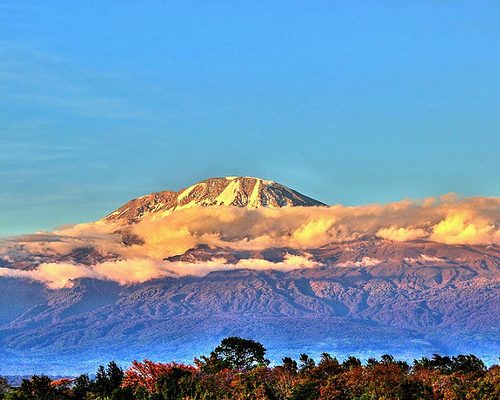
Day 1: From your overnight hotel in Moshi -Breakfast 8.30am drive to Marangu Gate and Sighn in your Mountain Climb. After registration,s tart the trek to Mandara Hut at 2,700m, 3-4hrs walk. Dinner and overnight Mandara Hut.
Day 2: After breakfast 9.00am from the Rainforests, you pass through heather and open moorland forests where giant lobelia and huge Cactus-like groundsel grow to reach to the second Hut at -Horombo at 3,700m Via Maundi Crater for dinner and overnight ( 5-4hrs.) walk.
Day 3: A full day to spend at Horombo Hut this day you will take a sidetrack to Mawenzi Hut to acclimatise your body for the following day. Dinner and overnight at Horombo Hut.
Day 4: Breakfast 9.00am start to the Landscape of an alpine desert about 5-7hrs walk to Kibo Hut at 4,750m for dinner and overnight.
Day 5: About 12.30-7.00 midnight /am, only black Tea/Coffee shall be taken, start to the summit Uhuru peak at 5,896m BRAVO !!! You then descend via Gilmans point at 5,600m about 6-7hrs to the summit picture short, rest return to Kibo Hut for breakfast, short rest proceed down to Horombo Hut for Dinner and Over Night.
Day 6: Breakfast 9.00am, descend down to Mandara Hut 3-4hrs for dinner and overnight.
Day 7: Breakfast 9.00am, trek down to Marangu Gate 3hrs walk-pick up for Moshi /Arusha for dinner and overnight.
10 Days Birding Safari Tanzania
Day 1: Arrival, Meet our Representative /Driver /Guide, Pickup from Point of entry (Kilimanjaro International Airport). You will be driven in a 4WD Minibus/Land Cruiser /Land Rover ,depending on group size, in either case the Safari Vehicles are specially designed for Safari with pop-up roofs for game viewing and a guaranteed window seat for each passenger .
Pick up and drop at Namanga the Kenya/Tanzania Border is possible and arrangements can also be made to pick up at Airport from Nairobi Kenya or arrange pick up in Nairobi by Shuttle bus, Nairobi – Arusha .
Transfer to Arusha Town with Dinner and Overnight at Ilboru Safari Lodge.You will be briefed by your Tour Leader on arrival at the Lodge
Extra Border Transfers shall be charged if arrivals shall any other than Kilimanjaro Airport. Enquire current transfer charges. Visas will also be required depending on Nationalities-you can acquire Visas on arrival at the Border crossing.
Day 2: The day begins with pre Breakfast birding around the lodge grounds,sighting small flocks of African fire finches,variable Sunbirds,Common Bulbuls and Olive Thrush. Breakfast and head north of Arusha to experience a walking safari ,visiting Arusha’s only reliable site of White Fronted bee eaters then go searching for the rare Spike heeled Lark in the open grass lands of Oldonyo Sambu village; Spectacled Rechinow`s weavers,Yellow bellied eremomella,Vonderdakens and Red billed Hornbills and many dry country specialities shall be identified, we then have our Bush lunch under a tree shade as the sun will be at its hottest period of the day. We return to our lodge in the afternoon and continue with local birding around the Lodge.Dinner and Overnight.
Day 3: Early break fast with our Lunches packed, we drive the long journey to the Serengeti arriving in the evening. A variety of Sand grouses ,Guinea fowls and Red necked Fracolins should be parading our way as we drive to the Lodge. Dinner and overnight at Ikoma Bush Tented Camp.
Day 4: Pre breakfast. searching for Tanzanian endemics in the Serengeti to include; the Fischer’s Lovebird and Grey breasted Spurfowl. Return to the Lodge for breakfast.
After breakfast we then go out for the rest of the day birding and game viewing; the Usambiro Barbets and the Grey capped social weaver ,as well the Secretary Bird and the Kori Bustard should be displaying as we drive along. Returning in the evening to your Tented Camp for Dinner and Overnight.
Day 5: Second day of Full day Birding and game viewing on the Serengeti plains.
Day 6: After our breakfast, we drive out of the Serengeti into the Ngorongoro crater where our highlight will be the endemic Rufous tailed weaver. If chance avails the golden winged Sunbird should be spotted as well as a large flocks of both lesser and greater Flamingoes on the Magadi soda lake on the crater floor,a variety of Raptors should be seen above the skies to include the Tawny and Warlberg`s Eagle. Many large mammals shall also be added on our list. Dinner and Overnight at Ngorongoro Sopa Lodge.
Day 7: The Day begins with an early breakfast, then drive to Tarangire with our packed Lunches, the highlights of the day is searching for the Tanzanian endemics ,again that will include the Rufous Tailed weaver, Yellow collard Lovebird and Ashy Stirling,the later occurring in only Tarangire. Dinner and overnight at the Tarangire Porini Luxury Tented Lodge.
Day 8: After breakfast, do the Tarangire for a full day for birding along the River Bank.
The Red fronted Parrot, Red fronted Tinker bird and Magpie Shrike could be the new ones for the day. Over night at Tarangire Safari Lodge.
Day 9: Walking the neighbouring Maasai villages for birding ,return in the afternoon and bird locally around your Lodge. Evening go through your final tally of the check list. Dinner and Overnight at your Lodge.
Day 10: Tarangire – Arusha , catch PM flight home.
If there will be need to overnight in Arusha so a s to catch up with flights the next day, accommodation arrangements shall be made and clients will pay services direct to Hotel/Lodge in Arusha. Range of Hotel/Lodge in Arusha to be booked for the last night can be discussed on arrival.

